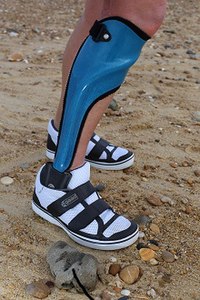
Photo from wikipedia
Abstract Purpose Paediatric foot surgery is often performed to restore anatomical shape or range of movement (ROM). The purpose of this study was to determine how foot morphology and ROM… Click to show full abstract
Abstract Purpose Paediatric foot surgery is often performed to restore anatomical shape or range of movement (ROM). The purpose of this study was to determine how foot morphology and ROM are associated with foot function in children aged five to 16 years of age. Methods Participants included 89 patients with foot disorders and 58 healthy controls. In addition to measuring children’s foot alignment and ankle ROM, children and parents completed the Oxford Ankle and Foot Questionnaire (OxAFQ). Results Mean age was 10.3 years for patients and 10.6 years for controls; 53 of 89 patients had clubfoot. All foot measurements and scores on the OxAFQ significantly differed (p < 0.001) between patients and controls. Patients and their parents significantly differed on the physical (p = 0.03) and emotional (p = 0.02) domains of the OxAFQ, with parents’ ratings being lower than their children. Moderate correlations (r = 0.54 to 0.059; p < 0.001) were found between physical domain (reported by parents on the OxAFQ) and dorsiflexion-knee flexed, and foot- arc-of-movement. Moderate correlations were found between physical domain (reported by children on OxAFQ) and foot-arc-of-movement (r = 0.56; p < 0.001). Patients in the surgical group showed moderate correlations (r = 0.57;, p < 0.001) between physical domain (reported by children on OxAFQ) and plantar flexion, and foot arc-of-movement. The control group and the patients in non-surgical subgroup showed no significant correlations. Conclusion Plantar flexion, arc of ankle ROM and hindfoot alignment impact foot function in children with foot deformities. Parents report significantly lower scores on the OxAFQ when judging foot functioning. Level of evidence Level II. Prognostic Studies
Journal Title: Journal of Children's Orthopaedics
Year Published: 2019
Link to full text (if available)
Share on Social Media: Sign Up to like & get
recommendations!